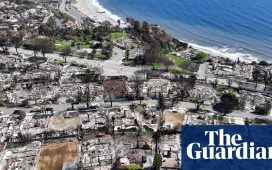I thought we were done with masks. But no. New Yorkers were wearing them again last week, at least those of us who dared to go out on the street, as the city was blanketed with thick plumes of smoke from Canadian wildfires that have been burning for more than a month. School and outdoor events were cancelled and residents were warned to stay inside, as air quality hit its worst recorded level ever. New York became, albeit briefly, one of the most dangerous places on the planet to breathe.
Bizarre as it was to see the city covered in a Delhi-esque haze, this was no black swan event. Wildfires have raged in recent years across California, south-east Australia, Canada and parts of the Mediterranean, thanks to higher temperatures and longer dry seasons. According to the reinsurer Munich Re, global losses from wildfires between 2018 and 2022 reached $69bn, with insurers paying out $39bn in claims.
Four out of the five of most economically costly wildfires in the past decade have been in California. That’s a big reason that State Farm, one of the country’s largest insurance companies, announced late last month that it would stop selling coverage to California homeowners — not just those in wildfire zones but everywhere across the state.
Allstate, the fourth largest property insurer in California, is also holding off on signing new policies. Between wildfires, rising sea levels and non-climate related problems such as the high replacement costs for homes, California has become by some measures the most uninsurable state in the US.
Florida, Texas, Colorado, Louisiana and New York aren’t far behind, however, as climate change-related natural disasters make it much harder — in some cases even impossible — to insure homes and commercial properties there as well. In hurricane-prone Florida, which is also notorious for insurance fraud, many big providers have pulled out, leaving the market to a handful of smaller players that are struggling to survive. Homeowner premiums in the state were just under triple the national average last year, according to the Insurance Information Institute.
But amazingly, that hasn’t stopped people from building, or moving, to Florida — the state population (more than three-quarters of which lives in a coastal area) went up 15 per cent from 2010-20, even as places such as Miami are very clearly sinking. Last year, while travelling to a conference in South Beach, I noticed water rising in the street. By the time my taxi got to the venue, I had to roll up my jeans to wade across the street to the beachfront hotel. Despite such clear indications that the coastline has a sell-by date, there were new condos going up all around me. I asked the driver, a life-long resident, what he thought. “The weather is definitely getting worse,” he said. “But the people that buy these things have so much money that they don’t care if the buildings are washed away in 20 years.”
Certainly that’s true in parts of Miami and California. It’s less true in, say, Louisiana, a poor state now offering millions of dollars in subsidies to lure insurers back into the market, or eastern Kentucky where the price of flood insurance is set to quadruple. But one can hardly blame the insurance companies for their reluctance to be in these markets given the rise in the accumulation of risk in disaster-prone areas. There is also the overall jump in residential building replacement costs nationally, which have risen more than 55 per cent since 2019 thanks to labour and materials inflation.
Indeed there is a strong argument to be made that America has been unwisely subsidising risk for decades through things such as federal flood insurance, which is slowly but surely being phased out by the government. Federal flood insurance has kept average premiums less than half of what they might be if risk was priced appropriately. Meanwhile, states such as California have rules dating back to the 1980s that bar insurers from pricing risk prospectively based on new and improved climate models, or incorporating the cost of reinsurance (also rising).
As prices increase, we will surely see some demographic shifts away from uninsurable parts of America. Those who stay in place are likely to be rich enough to afford the rising premiums, or become much more vulnerable. The White House is offering some help on the latter front, with $24bn put towards increasing climate resistance in at-risk communities.
But the insurance industry needs to become more proactive too. “We need to move from a detect and correct mindset to a repair and prevent model,” says Insure Information Institute chief executive Sean Kevelighan. He wants the industry to work more closely with the building trades and real estate agents to better publicise the potential risks and costs of insurance in vulnerable areas.
This isn’t a trend that’s likely to be limited to the US either. A recent Munich Re report looking at America’s wildfire issues notes “similar developments can be seen in many parts of the world, including the European Mediterranean region or parts of Australia. Given the high exposed values in these areas, risk management needs to keep a close eye on these developments.”
Climate Capital

Where climate change meets business, markets and politics. Explore the FT’s coverage here.
Are you curious about the FT’s environmental sustainability commitments? Find out more about our science-based targets here











